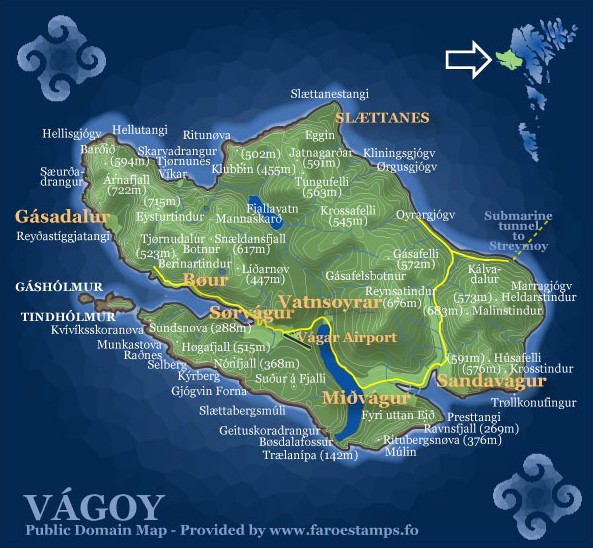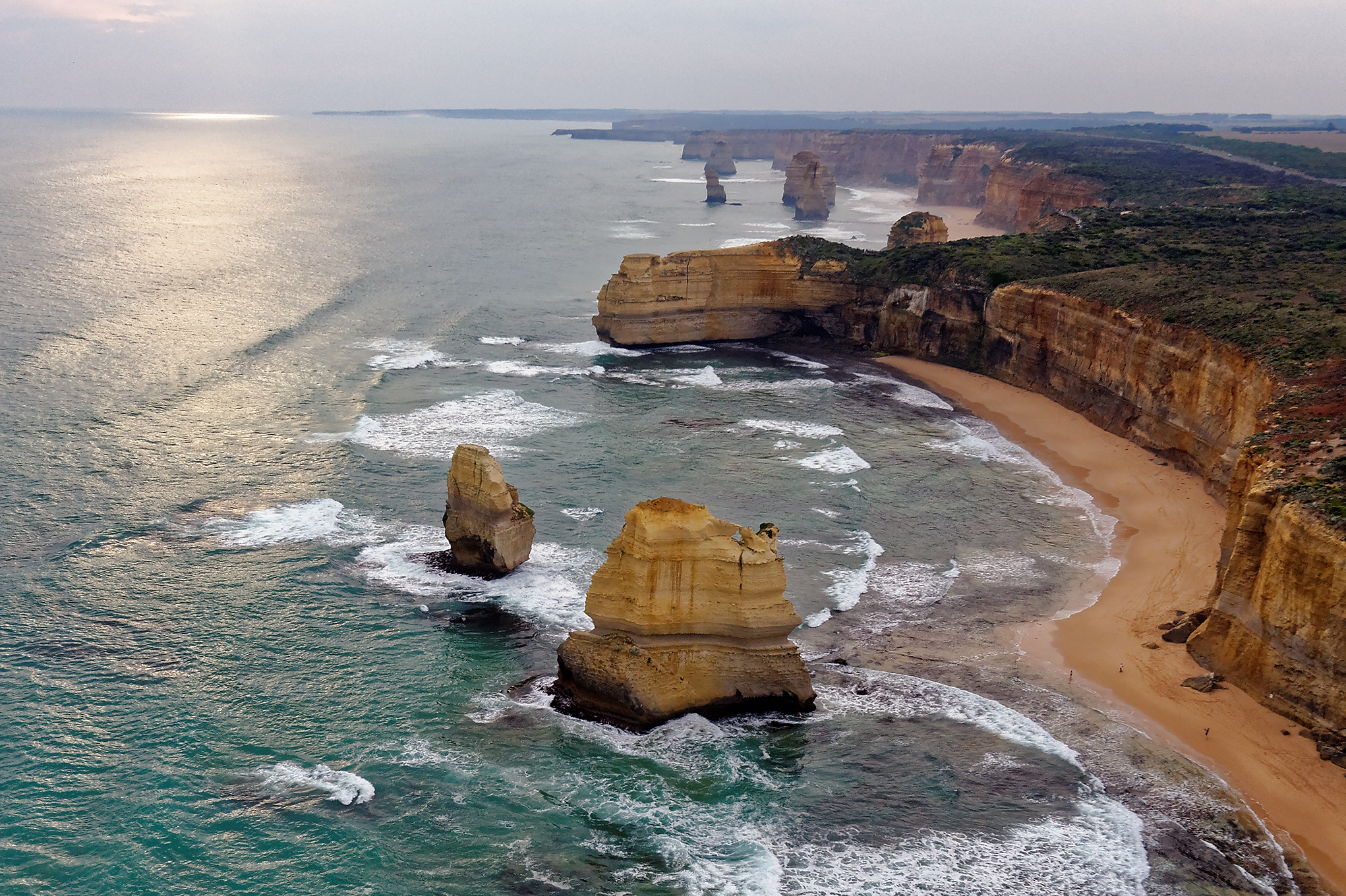|
Sørvágsfjørður
Sørvágsfjørður is a fjord on the west side of the island of Vágoy in the Faroe Islands which is approximately long. At the end of the fjord lies the village of Sørvágur. On the northside of the fjord lies the small village of Bøur. On the south side of the fjord lies the picturesque Tindhólmur islet, flanked by the Drangarnir sea stacks and Gáshólmur islet. Roughly in the middle of the fjord lies Skerhólmur. During World War II many British soldiers lived in Sørvágur. Sørvágsfjørður is mentioned in the Pioneers from the WW2 Museum, Krígssavnið, in Miðvágur. The Royal Pioneers who were in the Faroe Islands The Faroe Islands ( ) (alt. the Faroes) are an archipelago in the North Atlantic Ocean and an autonomous territory of the Danish Realm, Kingdom of Denmark. Located between Iceland, Norway, and the United Kingdom, the islands have a populat ... from 1941 until the end of the war published their own newspaper. References External lin ... [...More Info...] [...Related Items...] OR: [Wikipedia] [Google] [Baidu] |
Tindhólmur
Tindhólmur is an islet on the southside of Sørvágsfjørður, west of Vágar in the Faroe Islands The Faroe Islands ( ) (alt. the Faroes) are an archipelago in the North Atlantic Ocean and an autonomous territory of the Danish Realm, Kingdom of Denmark. Located between Iceland, Norway, and the United Kingdom, the islands have a populat .... It has its name from the five peaks, which are named ''Ytsti, Arni, Lítli, Breiði, Bogni'' (Farthest, Eagle, Small, Broad, Bent). The islet is uninhabited. It has an area of – or in old Faroese style, two ''merkur'' – and its highest point is at an elevation of . Formerly, it was a nesting place for the white-tailed eagle. Eiriksboði Eiriksboði is a rocky formation stretching out from the islet. References External links * {{DEFAULTSORT:Tindholmur Islets of the Faroe Islands Vágar Uninhabited islands of the Faroe Islands ... [...More Info...] [...Related Items...] OR: [Wikipedia] [Google] [Baidu] |
Sørvágur
:''There is also a town called Vágur on Suðuroy.'' Sørvágur () is a village on the island of Vágar in the Faroe Islands. It is located at the landward end of Sørvágsfjørður. Sørvágur is the largest village in Sørvágur Municipality. Name The name Sørvágur translates to "The Bay of Sør". While the second half of the name makes sense given the fact that the village is located at a bay, the first half is more mysterious. Legend has it that the first man to settle at this place was called 'Sørli' and hence the village was named in honour of him. Another explanation on the origin of 'Sør' comes from the old-Norse 'Seyr' which is a word for sand (seyr is also a word for foggy rain). Sørvágur has quite a large sandbeach in comparison with other Faroese villages and towns, and therefore it was speculated that the original name of Sørvágur was ''Seyrvágur'', and during the course of time, Seyrvágur became Sørvágur. During the first half of the 20th century, local ... [...More Info...] [...Related Items...] OR: [Wikipedia] [Google] [Baidu] |
Gáshólmur
Gáshólmur is a small islet on the southside of Sørvágsfjørður in the Faroe Islands. To the east of the islet lies another islet, Tindhólmur. The islet is uninhabited, and the only living creatures are seabirds and sheep rams, which are placed on the islet each year by the locals in Sørvágur :''There is also a town called Vágur on Suðuroy.'' Sørvágur () is a village on the island of Vágar in the Faroe Islands. It is located at the landward end of Sørvágsfjørður. Sørvágur is the largest village in Sørvágur Municipality. .... There is a lighthouse at the north-western extremity of the islet. * Highest point: 65 m * Size: 10 ha References Islets of the Faroe Islands Uninhabited islands of the Faroe Islands Vágar {{faroes-geo-stub ... [...More Info...] [...Related Items...] OR: [Wikipedia] [Google] [Baidu] |
Skerhólmur
 Skerhólmur is a small islet in the middle of Sørvágsfjørður on the island of Vágar, Faroe Islands.
It is uninhabited.
Islets of the Faroe Islands
Uninhabited islands of the Faroe Islands
Vágar
{{Faroes-geo-stub ...
Skerhólmur is a small islet in the middle of Sørvágsfjørður on the island of Vágar, Faroe Islands.
It is uninhabited.
Islets of the Faroe Islands
Uninhabited islands of the Faroe Islands
Vágar
{{Faroes-geo-stub ...
[...More Info...] [...Related Items...] OR: [Wikipedia] [Google] [Baidu] |
Vágar
Vágar (; ) is one of the 18 islands in the archipelago of the Faroe Islands and the most westerly of the ''large islands''. With a size of , it ranks third in size, behind Streymoy and Eysturoy. Vágar Regions of the Faroe Islands, region also comprises the island of Mykines, Faroe Islands, Mykines. The Vágar island shape is very distinctive, since on maps it resembles a dog's head. The fjord Sørvágsfjørður is the mouth and the lake Fjallavatn is the eye. History Vágar is the first port of call for most foreigners travelling to the Faroe Islands, as it is home to the islands’ only airport, Vágar Airport. An airfield was built there during World War II by the British, who occupied the Faroe Islands with the islanders' consent. After the war it lay unused for about 20 years, but was then put back into service and expanded/modernised as required. It handles about 290,000 passengers a year (2016). Such large numbers by Faroese standards put a considerable strain on transpo ... [...More Info...] [...Related Items...] OR: [Wikipedia] [Google] [Baidu] |
Bøur
Bøur () is a village in the Sørvágur Municipality of the Faroe Islands, 4 km west of Sørvágur, with a population of 75 (2012). - Municipality website Its location is and its postal code is FO 386. It is linked to the village of Gásadalur by the Gásadalstunnilin tunnel. Bøur is a small village on the west-side of on the north side of Sørvágsfjørður, |
Faroe Islands
The Faroe Islands ( ) (alt. the Faroes) are an archipelago in the North Atlantic Ocean and an autonomous territory of the Danish Realm, Kingdom of Denmark. Located between Iceland, Norway, and the United Kingdom, the islands have a population of 54,609 and a land area of 1,393 km². The official language is Faroese language, Faroese, which is partially mutually intelligible with Icelandic language, Icelandic. The terrain is rugged, dominated by fjords and cliffs with sparse vegetation and few trees. As a result of its proximity to the Arctic Circle, the islands experience perpetual Twilight, civil twilight during summer nights and very short winter days; nevertheless, they experience a Oceanic climate#Subpolar variety (Cfc, Cwc), subpolar oceanic climate and mild temperatures year-round due to the Gulf Stream. The capital, Tórshavn, receives the fewest recorded hours of sunshine of any city in the world at only 840 per year. Færeyinga saga, Færeyinga Saga and the writin ... [...More Info...] [...Related Items...] OR: [Wikipedia] [Google] [Baidu] |
Drangarnir
Drangarnir is the collective name for two sea stacks between the islet Tindhólmur and the island Vágar in the Faroe Islands The Faroe Islands ( ) (alt. the Faroes) are an archipelago in the North Atlantic Ocean and an autonomous territory of the Danish Realm, Kingdom of Denmark. Located between Iceland, Norway, and the United Kingdom, the islands have a populat .... The individual names of the sea stacks are '' Stóri Drangur'' (en: Large sea stack) and '' Lítli Drangur'' (en: Small sea stack). References Stacks of the Faroe Islands Vágar {{Faroes-geo-stub ... [...More Info...] [...Related Items...] OR: [Wikipedia] [Google] [Baidu] |
Sea Stacks
A stack or sea stack is a geological landform consisting of a steep and often vertical column or columns of rock in the sea near a coast, formed by wave erosion. Stacks are formed over time by wind and water, processes of coastal geomorphology. britannica.com They are formed when part of a is by hydraulic action, which is the force of the sea or water crashing against the rock. The force of the water weakens cracks in the headland, causing them to later collapse, ... [...More Info...] [...Related Items...] OR: [Wikipedia] [Google] [Baidu] |
Miðvágur
Miðvágur (), is a village in the Faroe Islands on Vágar. It has been a municipality until 1 January 2009 when it fused with Sandavágur into Vága kommuna. Located on the south coast of the island of Vágar, Miðvágur is the largest town on this Faroese island. For years, Miðvágur has been known as a good location for whaling and traditionally, bells would ring with the cry "''Grindaboð''!" - "Pilot whale ahoy!" History Miðvágur has been inhabited since at least the Viking Age —as excavations have demonstrated. Since these early times, there has been a local "Thingstätte" (local community council), or "Várting". The most interesting building of the village is ''Kálvalíð'', a house which was probably built at the end of the Middle Ages. It is the oldest building of the village and possibly of the whole Faroe Islands. Kálvalíð consists of two rooms with a turf roof, built in the traditional faroese style. Today it houses a museum. Sports The local football team ... [...More Info...] [...Related Items...] OR: [Wikipedia] [Google] [Baidu] |

